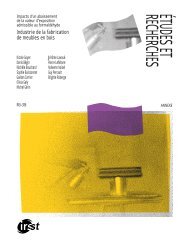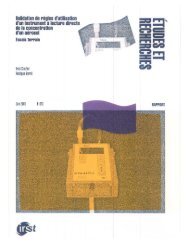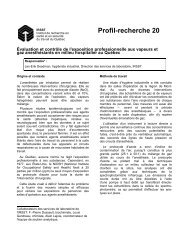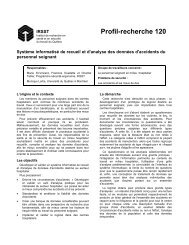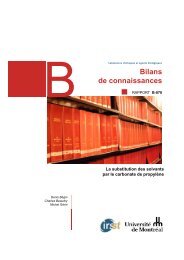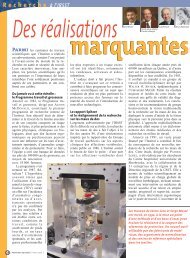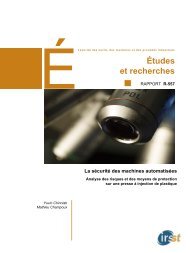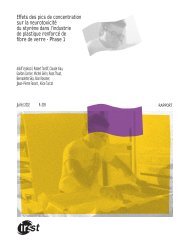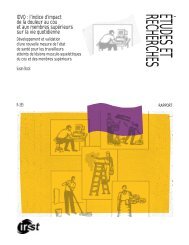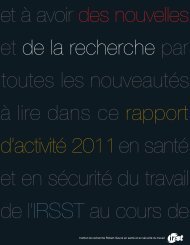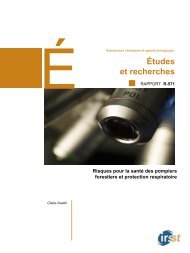Sampling Guide for Air Contaminants in the Workplace - Irsst
Sampling Guide for Air Contaminants in the Workplace - Irsst
Sampling Guide for Air Contaminants in the Workplace - Irsst
You also want an ePaper? Increase the reach of your titles
YUMPU automatically turns print PDFs into web optimized ePapers that Google loves.
12 IRSST – <strong>Sampl<strong>in</strong>g</strong> <strong>Guide</strong> <strong>for</strong> <strong>Air</strong> <strong>Contam<strong>in</strong>ants</strong> <strong>in</strong> <strong>the</strong> <strong>Workplace</strong><br />
an imag<strong>in</strong>ary l<strong>in</strong>e jo<strong>in</strong><strong>in</strong>g <strong>the</strong> ears."<br />
In <strong>the</strong> case of groups of workers, if <strong>the</strong> prelim<strong>in</strong>ary evaluation did not produce data on homogeneous<br />
exposure, samples must be used to establish <strong>the</strong> variability of this exposure over time (day, night, seasons,<br />
climatic conditions, dur<strong>in</strong>g certa<strong>in</strong> operations, etc.) and <strong>in</strong> space (different workstations or emission sources).<br />
The result of a s<strong>in</strong>gle sample that covers <strong>the</strong> complete 8-hour period can be compared directly to <strong>the</strong> TWAEV,<br />
or if it covers a 15-m<strong>in</strong>ute period, to <strong>the</strong> STEV. In <strong>the</strong> case of unusual schedules, <strong>the</strong> s<strong>in</strong>gle sample must cover<br />
<strong>the</strong> total duration of <strong>the</strong> work shift and <strong>the</strong> result compared to <strong>the</strong> AMEV.<br />
Consecutive samples cover<strong>in</strong>g <strong>the</strong> entire work period offer <strong>the</strong> same advantage as s<strong>in</strong>gle samples regard<strong>in</strong>g<br />
comparison with <strong>the</strong> appropriate reference value. This strategy can also provide <strong>in</strong><strong>for</strong>mation on <strong>the</strong> variation<br />
<strong>in</strong> <strong>the</strong> concentration of a contam<strong>in</strong>ant dur<strong>in</strong>g <strong>the</strong> work period and allows a sample contam<strong>in</strong>ated voluntarily or<br />
accidentally to be identified.<br />
Multiple partial-period samples may be satisfactory, depend<strong>in</strong>g on <strong>the</strong> <strong>in</strong><strong>for</strong>mation on <strong>the</strong> homogeneity of <strong>the</strong><br />
exposure results. In general, with homogeneous exposure, <strong>the</strong> mean daily exposure (MDE) can be calculated<br />
from multiple samples of a total duration of at least two hours or from 5 samples <strong>for</strong> <strong>the</strong> duration prescribed <strong>in</strong><br />
<strong>the</strong> reference method, and where <strong>the</strong>se samples are distributed uni<strong>for</strong>mly with<strong>in</strong> an eight-hour time period <strong>in</strong> a<br />
workday or <strong>for</strong> <strong>the</strong> duration of <strong>the</strong> work shift <strong>in</strong> <strong>the</strong> case of an unusual schedule. Several examples of<br />
calculations of <strong>the</strong> TWAEV, one example of a calculation of <strong>the</strong> R m (sum of <strong>the</strong> fractions of <strong>the</strong> mixture<br />
dur<strong>in</strong>g daily exposure to several substances), and one example of an application of <strong>the</strong> excursion limit are<br />
presented <strong>in</strong> section 1.2.1.<br />
In certa<strong>in</strong> cases, due to limitations <strong>in</strong> <strong>the</strong> methods or measur<strong>in</strong>g <strong>in</strong>struments that require short-term samples, a<br />
series of grab samples can be collected at random <strong>in</strong>tervals dur<strong>in</strong>g <strong>the</strong> entire work period or <strong>the</strong> period of<br />
application of <strong>the</strong> standard. Grab samples are also used to compare <strong>the</strong> concentration of one contam<strong>in</strong>ant to a<br />
ceil<strong>in</strong>g value. In this case, <strong>the</strong> m<strong>in</strong>imum sampl<strong>in</strong>g period must take <strong>in</strong>to account <strong>the</strong> analytical limitations of<br />
response time, <strong>in</strong>strument stability, or o<strong>the</strong>rs that are described <strong>in</strong> <strong>the</strong> IRSST's analytical and calibration<br />
methods. Even <strong>in</strong> <strong>the</strong> case of ceil<strong>in</strong>g values, result <strong>in</strong>terpretation must take <strong>in</strong>to account <strong>the</strong> precision and<br />
accuracy of <strong>the</strong> technique, and establish <strong>the</strong> reliability of <strong>the</strong> comparison of <strong>the</strong> results and <strong>the</strong> limit value<br />
us<strong>in</strong>g normal statistics.<br />
Figure 7 summarizes <strong>the</strong> time characteristics of <strong>the</strong> different types of sampl<strong>in</strong>g <strong>in</strong> characteriz<strong>in</strong>g a TWAEV.<br />
Several factors have an impact on <strong>the</strong> choice of one strategy over ano<strong>the</strong>r. The availability and cost of <strong>the</strong><br />
sampl<strong>in</strong>g equipment, access to <strong>the</strong> workplace, variability <strong>in</strong> <strong>the</strong> processes, <strong>the</strong> precision and accuracy of <strong>the</strong><br />
methods, and <strong>the</strong> number of samples, are all factors to be considered <strong>in</strong> choos<strong>in</strong>g a strategy. Of <strong>the</strong> four types<br />
of samples described, <strong>the</strong> results most representative of <strong>the</strong> actual situation <strong>in</strong>volve collect<strong>in</strong>g several<br />
consecutive samples over <strong>the</strong> entire work period. The second choice would be to collect a s<strong>in</strong>gle sample over<br />
<strong>the</strong> entire period. The <strong>in</strong>terpretation of <strong>the</strong> results of partial-period samples, and <strong>the</strong> grab sample applied to <strong>the</strong><br />
TWAEV, AMEV or to <strong>the</strong> STEV, require a good knowledge about <strong>the</strong> homogeneity of <strong>the</strong> exposure and an<br />
appropriate statistical analysis.<br />
1.1.6 Frequency of environmental monitor<strong>in</strong>g<br />
Pursu<strong>in</strong>g long-term objectives <strong>in</strong> <strong>the</strong> evaluation and effectiveness of means of control and elim<strong>in</strong>ation at<br />
source, or obta<strong>in</strong><strong>in</strong>g exposure value results that are close to <strong>the</strong> reference value, raise <strong>the</strong> question of <strong>the</strong><br />
frequency of environmental monitor<strong>in</strong>g (step ). In certa<strong>in</strong> cases, a m<strong>in</strong>imum frequency is provided <strong>in</strong> <strong>the</strong><br />
Québec regulation. For example, <strong>for</strong> asbestos, <strong>the</strong> ROHS specifies <strong>in</strong> section 43 that:<br />
"In any establishment where workers are exposed to asbestos, <strong>the</strong> employer must at least once a year<br />
measure <strong>the</strong> concentration of airborne asbestos dust and <strong>the</strong> concentration of respirable asbestos<br />
fibres <strong>in</strong> <strong>the</strong> workers' breath<strong>in</strong>g area. A sampl<strong>in</strong>g strategy may provide <strong>for</strong> more frequent measur<strong>in</strong>g,<br />
depend<strong>in</strong>g on <strong>the</strong> extent of <strong>the</strong> risk to <strong>the</strong> health, safety or physical well-be<strong>in</strong>g of <strong>the</strong> workers." The<br />
same regulation sets <strong>the</strong> same frequency requirement <strong>for</strong> any establishment that employs 50 workers<br />
or more, "… where <strong>the</strong> concentration of gases, dusts, fumes, vapours or mists at a work location<br />
exceeds or could exceed <strong>the</strong> standards prescribed <strong>in</strong> Schedule 1…"



